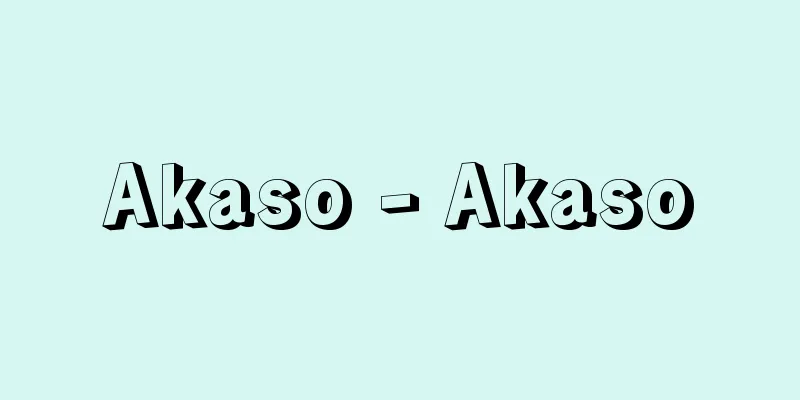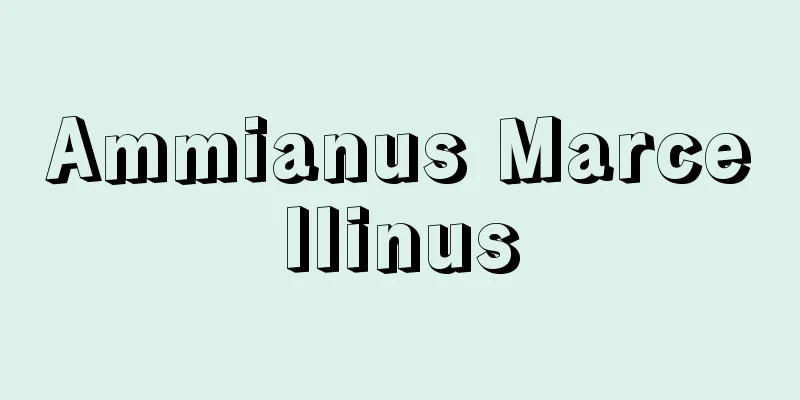Okurigana - Okurigana

|
When a word is written in kanji and kana, this refers to the kana portion written after the kanji. In the past, it was also called secondary kana or discarded kana. It indicates the end of a word to clarify the pronunciation of the kanji and to prevent misreading. The kana portion that writes a prefix, suffix, or part of a Chinese word, such as " Oniisan " (older brother ) and " Sushishin" (shitsushin ), is not an okurigana because it is not intended to clarify the pronunciation of the kanji. [Takuya Okimori] The history of okuriganaThe use of okurigana began when the readings of Chinese characters were borrowed and used to write Japanese. It can be seen in Man'yōgana as early as the Nara period, such as "Tsune ni omohedo" (Man'yōshū, volume 4) and "Hokashiki koto majieba" (Senmyo, 9th year of Tenpyō Shōhō). The latter Senmyo style became the hiragana Senmyo style and the katakana Senmyo style as kana developed, and small kana characters were often written larger from the Middle Ages onwards. Kanji characters also gradually began to be mixed in hiragana writing, leading to the use of okurigana. Writing the readings of Chinese characters next to them at the reading marks in classical Chinese is similar in form. However, the way in which okurigana is added is not uniform, and in many cases inflected endings were not written. When the reading is clear, there is no need to add okurigana, so there was no rule that inflected endings were added. Since such a chaotic way of adding okurigana was inconvenient in practice, the organization and standardization of okurigana began to be advocated after the Meiji period. Several rules on how to add okurigana, or okurigana laws, were proposed, but the okurigana law proposed by the National Language Research Committee in 1907 (Meiji 40) was relatively widely adopted. In 1959 (Showa 34), the first official standard "How to Use Okurigana" was established by Cabinet Order and Public Notice, after a period of inconsistency up until that point. This was revised and the "How to Use Okurigana" was promulgated by Cabinet Order and Public Notice in 1973. This consists of seven general rules, with exceptions and allowances in addition to the main rules. Compared to the previous version, there are many more exceptions and allowances, and their application is left to the free choice of each individual. [Takuya Okimori] How to add revised trailing kanaThe outline is given below (examples are in brackets). General rule 1: Main rule - For conjugated words (excluding words to which general rule 2 applies), use the conjugation endings ( angry , rough , masterful ). Exceptions: Adjectives whose stems end in shi are sent from shi ( remarkable ), and adjectival verbs that include ka, yaka, or raka before the conjugation ending are sent from the syllable ( warm , calm ). Also, "ajiwau, awareda" (taste, pitiful) and other words are sent from the syllable ( taste , pitiful ). Allowance -〈to represent ( represent ), to perform ( perform )〉 etc. can be sent as shown in ( ). Note: For verbs where it is difficult to distinguish between the stem and the conjugation suffix, use conjugations such as "kiru (wear) , neru (sleep) , kuru (come )." General Rule 2 Main Rule: Words which contain other words in any part other than the conjugation ending are advanced by adding the okurigana of the contained words (the contained words are shown in [ ]): ( to move (mugoku), to be brave (yumu), to value (heavy), to be detailed (fine), to be sweaty (sweat), to feel guilty (behind)). Acceptance - In words such as " ukau (floating)," " hareyaka da (hareyaka da)," the trailing kana can be omitted as shown in parentheses. Note: Words such as 'bright (beautiful), 'regretful (regretful),' etc. are not considered to include the word in [ ], and are to be governed by General Rule 1. General Rule 3 Main Rule: Nouns (except for words to which General Rule 4 applies) should not have okurigana added (such as "tsuki" (moon), "otoko" (man), "kare" (he). Exceptions: "Ari" (surrounding ), "Joake" (feeling), "Jibun" (oneself ), etc., are used to add the last syllable. Nouns that contain the "tsu" (counting) are used to add the "tsu" ( one , how many ). General Rule 4 Main Rule: Nouns derived from conjugated words, and nouns formed by adding suffixes such as sa, mi, ge to conjugated words, are converted into nouns using the okurigana used in the original word ( movement , size , brightness , reluctance ). Exceptions: In the case of "utai" (a chant), "ori" (folding), etc., no trailing kana is added. However, this exception does not apply in cases where the consciousness of the verb remains. Acceptable - In words such as 〈 kumori (cloudy)〉 and 〈atari (atari)〉, the trailing kana can be omitted as shown in parentheses. General Rule 5 Main Rule - Adverbs, conjunctions, and conjunctions add the final syllable such as " will surely , will come , and ." Exceptions: "Akuru, ooini" are followed by " Akuru , dai ni ". "Mata" is not followed by an okurigana. Words that contain other words are followed by the okurigana used for the words they contain ("awase" ( additionally ), "barely " (painful)). General Rule 6 Main Rule - The okurigana for compound words (excluding words to which General Rule 7 applies) is written in the same way as for single words using the on-yomi and kun-yomi of the kanji used to write the compound word (such as write through , diagonal left, rice planting , application , rest break ). Acceptable - In words such as ' gaku nukeru (to write out), taue (to plant rice), shinsyo (to apply, to apply), etc., the trailing kana can be omitted as shown in parentheses. General Rule 7 Main Rule: Among compound words, nouns that are recognized as having fixed usage in a specific field or in general do not have okurigana added (such as sekitori (sumo wrestler), Hakataori (ori), registered mail (shimetome), kidachi (kidzu), saizu (signature), and haikyuu (reception)). Note: When it is unclear whether a custom has become fixed or not and whether General Rule 7 applies, General Rule 6 applies. [Takuya Okimori] "Collection of Data on Okurigana" (Collection of Data on the National Institute for Japanese Language and Linguistics 3, 1952, National Institute for Japanese Language and Linguistics) ©Shogakukan "> Abbreviation of "Revised Okurigana Writing Method" Source: Shogakukan Encyclopedia Nipponica About Encyclopedia Nipponica Information | Legend |
|
単語を漢字と仮名で表記する場合、漢字のあとに書き添える仮名の部分をいう。古くは副(そえ)仮名、捨(す)て仮名ともいった。漢字の読みを明らかにし、誤読のないように、単語の末尾の部分を示すのである。「お兄さん」「湿しん」のように、接頭語、接尾語や漢語の一部などを記した仮名の部分は、漢字の読みを明らかにするためのものではないから、送り仮名ではない。 [沖森卓也] 送り仮名の歴史送り仮名は、漢字の訓義を借りて日本語の表記に用いた段階から行われたもので、「常念弊利(つねにおもへど)」(『万葉集』巻4)「他支事交倍波(ほかしきことまじへば)」(天平勝宝(てんぴょうしょうほう)九年宣命(せんみょう))など、奈良時代にすでに万葉仮名でみえる。後者の宣命体は仮名の発達に伴って平仮名宣命体、片仮名宣命体となり、中世以降は小字の仮名も大きく表記することが多くなった。また平仮名文でもしだいに漢字を交え用いるようになって、送り仮名が行われるに至った。漢文の訓点で漢字の読みを傍らに記入することも、形式的には似たものである。しかし、これらの送り仮名のつけ方は一様ではなく、活用語尾などは記さないことも少なくなかった。読みが明らかな場合には、ことさらに送り仮名をつける必要がないから、法則的に活用語尾などを送る習慣もなかったのである。 そのような無秩序なつけ方では実務上不便であることから、明治以降、送り仮名の整理統一が説かれるようになった。送り仮名のつけ方に関する規則、すなわち送り仮名法がいくつか提出されたが、なかでも1907年(明治40)の国語調査委員会「送仮名法」は比較的広く行われた。 1959年(昭和34)、それまでまちまちであった送り仮名法に対して、初めての公的な基準「送りがなのつけ方」が内閣訓令・告示をもって定められた。これを改定して、73年に「送り仮名の付け方」が内閣訓令・告示をもって公布された。これは七つの通則からなり、本則のほか例外、許容を設けている。改定前のものに比べて、例外、許容を大幅に認めるとともに、その運用は個々人の自由な選択にゆだねるようになっている。 [沖森卓也] 改定送り仮名の付け方その大要を次に示す(〈 〉内は語例)。 通則1 本則―活用のある語(通則2を適用する語を除く)は、活用語尾を送る〈憤る、荒い、主だ〉。 例外―語幹がシで終わる形容詞は、「し」から送り〈著しい〉、活用語尾の前にカ、ヤカ、ラカを含む形容動詞は、その音節から送る〈暖かだ、穏やかだ〉。また「あじわう、あわれだ」などは〈味わう、哀れだ〉のように送る。 許容―〈表す(表わす)、行う(行なう)〉などは、( )の中に示すように送ることができる。 注意―語幹と活用語尾との区別がつかない動詞は、たとえば〈着る、寝る、来る〉などのように送る。 通則2 本則―活用語尾以外の部分に他の語を含む語は、含まれている語の送り仮名の付け方によって送る(含まれている語を〔 〕の中に示す)〈動かす〔動く〕、勇ましい〔勇む〕、重んずる〔重い〕、細かい〔細かだ〕、汗ばむ〔汗〕、後ろめたい〔後ろ〕〉。 許容―〈浮かぶ(浮ぶ)、晴れやかだ(晴やかだ)〉などは、( )の中に示すように、送り仮名を省くことができる。 注意―〈明るい〔明ける〕、悔しい〔悔いる〕〉などは、〔 〕の中に示す語を含むものとは考えず、通則1によるものとする。 通則3 本則―名詞(通則4を適用する語を除く)は、送り仮名を付けない〈月、男、彼〉。 例外―〈辺り、情け、自ら〉などは、最後の音節を送る。数をかぞえるツを含む名詞は、その「つ」を送る〈一つ、幾つ〉。 通則4 本則―活用のある語から転じた名詞および活用のある語にサ、ミ、ゲなどの接尾語が付いて名詞になったものは、もとの語の送り仮名の付け方によって送る〈動き、大きさ、明るみ、惜しげ〉。 例外―〈謡、折〉などは、送り仮名を付けない。ただし、この例外は、動詞の意識が残っているような使い方の場合には該当しない。 許容―〈曇り(曇)、当たり(当り)〉などは、( )の中に示すように、送り仮名を省くことができる。 通則5 本則―副詞、連体詞、接続詞は、最後の音節を送る〈必ず、来る、及び〉。 例外―「あくる、おおいに」などは〈明くる、大いに〉のように送る。〈又〉は送り仮名を付けない。他の語を含む語は、含まれている語の送り仮名の付け方によって送る〈併せて〔併せる〕、辛うじて〔辛い〕〉。 通則6 本則―複合の語(通則7を適用する語を除く)の送り仮名は、その複合の語を書き表す漢字の、それぞれの音訓を用いた単独の語の送り仮名の付け方による〈書き抜く、斜め左、田植え、申し込み、休み休み〉。 許容―〈書き抜く(書抜く)、田植え(田植)、申し込み(申込み、申込)〉などは、( )の中に示すように、送り仮名を省くことができる。 通則7 本則―複合の語のうち、特定の領域で、または一般に慣用が固定していると認められる名詞は、送り仮名を付けない〈関取、博多織、書留、木立、合図、受付〉。 注意―慣用が固定しているかどうか、通則7の適用に判断がつかない場合には、通則6を適用する。 [沖森卓也] 『『送り仮名法資料集』(『国立国語研究所資料集 3』1952・国立国語研究所)』 ©Shogakukan"> 「改定送り仮名の付け方」の略表 出典 小学館 日本大百科全書(ニッポニカ)日本大百科全書(ニッポニカ)について 情報 | 凡例 |
Recommend
Eretria - Eretria (English spelling)
An ancient city on the island of Euboea in centra...
Aglaonema nitizum - Aglaonema nitizum
...There are many variations, and the leaves of P...
Everett's Interpolation Formula - Everett's Interpolation Formula
...For example , a table of function values, such...
Zachsia zenkewitschi (English spelling) Zachsiazenkewitschi
...The tail plug is long and shaped like a wheat ...
Inishmore
…Three islands at the mouth of Galway Bay in west...
Cercartetus concinnus
...Marsupial [Yoshiharu Imaizumi]. . … *Some of t...
Nāṭya‐śāstra (English spelling)
A Sanskrit treatise on classical Indian drama. It ...
Ising model - Ising model
A model that simplifies the Heisenberg model for f...
Monomolecular film
…When the concentration of fatty acid salt per su...
Cylindrocaulus patalis (English spelling)
...The black passal beetle, Aceraius grandis , is...
Atomic Energy Commission
The first organization named the Atomic Energy Co...
Morichika Kitabatake
...It is located in Oishi, Ryozen-cho, Date-gun, ...
Thymocytes
Also called thymic lymphocytes. These cells are de...
ghorkhar
...The main cause of the decline is said to be a ...
Current transfer, capital transfer
A transfer of purchasing power from one economic e...









